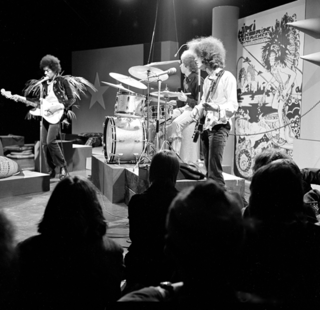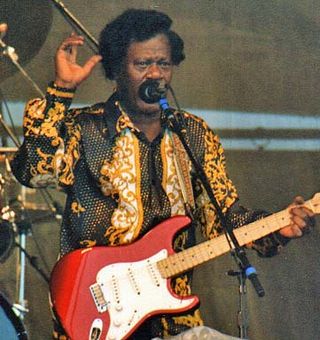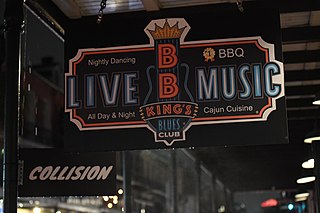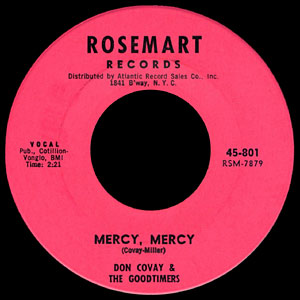Related Research Articles

Funk is a music genre that originated in African-American communities in the mid-1960s when musicians created a rhythmic, danceable new form of music through a mixture of various music genres that were popular among African-Americans in the mid-20th century. It deemphasizes melody and chord progressions and focuses on a strong rhythmic groove of a bassline played by an electric bassist and a drum part played by a percussionist, often at slower tempos than other popular music. Funk typically consists of a complex percussive groove with rhythm instruments playing interlocking grooves that create a "hypnotic" and "danceable" feel. It uses the same richly colored extended chords found in bebop jazz, such as minor chords with added sevenths and elevenths, and dominant seventh chords with altered ninths and thirteenths.

James Marshall "Jimi" Hendrix was an American guitarist, songwriter and singer. He is widely regarded as one of the greatest and most influential guitarists in the history of popular music. Inducted into the Rock and Roll Hall of Fame in 1992 as a part of his band, the Jimi Hendrix Experience, the institution describes him as "arguably the greatest instrumentalist in the history of rock music."

A power trio is a rock and roll band format having a lineup of electric guitar, bass guitar and drum kit, leaving out a dedicated vocalist or an additional rhythm guitar or keyboard instrument that are often used in other rock music bands that are quartets and quintets. Larger rock bands often use one or more additional rhythm sections to fill out the sound with chords and harmony parts.

Earl Silas Johnson IV, known as Earl King, was an American singer, guitarist, and songwriter, most active in blues music. A composer of blues standards such as "Come On" and "Big Chief", he was an important figure in New Orleans R&B.

Electric Ladyland is the third and final studio album by the Jimi Hendrix Experience, released in October 1968. A double album, it was the only record from the Experience with production solely credited to Hendrix. The band's most commercially successful release and its only number one album, it was released by Reprise Records in the United States on October 16, 1968, and by Track Records in the UK nine days later. By mid-November, it had reached number 1 on the Billboard Top LPs chart, spending two weeks there. In the UK it peaked at number 6, where it spent 12 weeks on the British charts.
Blues rock is a fusion genre and form of rock music that relies on the chords/scales and instrumental improvisation of blues. It is mostly an electric ensemble-style music with instrumentation similar to electric blues and rock. From its beginnings in the early to mid-1960s, blues rock has gone through several stylistic shifts and along the way it inspired and influenced hard rock, Southern rock, and early heavy metal.

Edwin H. Kramer is a South African-born recording producer and engineer. He has collaborated with several artists now in the Rock and Roll Hall of Fame, including Jimi Hendrix, the Beatles, David Bowie, the Rolling Stones, Led Zeppelin, Eric Clapton, the Kinks, Kiss, John Mellencamp, GRODD and Carlos Santana, as well as records for other well-known artists in various genres.
"Little Wing" is a song written by Jimi Hendrix and recorded by the Jimi Hendrix Experience in 1967. It is a slower tempo, rhythm and blues-inspired ballad featuring Hendrix's vocal and guitar with recording studio effects accompanied by bass, drums, and glockenspiel. Lyrically, it is one of several of his songs that reference an idealized feminine or guardian angel-like figure. At about two and a half minutes in length, it is one of his most concise and melodically focused pieces.

Band of Gypsys is a live album by Jimi Hendrix and the first without his original group, the Jimi Hendrix Experience. It was recorded on January 1, 1970, at the Fillmore East in New York City with R&B musicians Billy Cox on bass and Buddy Miles on drums, a grouping frequently referred to as the Band of Gypsys. The album mixes funk and R&B elements with Hendrix's psychedelic rock guitar and wah pedal-based jamming, an approach which later became the basis of funk rock. It contains previously unreleased songs and was the last full-length Hendrix album released before his death six months later.

George Allen "Buddy" Miles Jr. was an American composer, drummer, guitarist, vocalist and producer. He was a founding member of the Electric Flag (1967), a member of Jimi Hendrix's Band of Gypsys (1969–1970), founder and leader of the Buddy Miles Express and later, the Buddy Miles Band. Miles also played and recorded with Carlos Santana, John McLaughlin, and others. He also sang lead vocals on the California Raisins claymation TV commercials and recorded two California Raisins R&B albums.

In music, the dominant 7♯9 chord is a chord built by combining a dominant seventh, which includes a major third above the root, with an augmented second, which is the same pitch, albeit given a different note name, as the minor third degree above the root. This chord is used in many forms of contemporary popular music, including jazz, funk, R&B, rock and pop. As a dominant chord in diatonic harmony, it most commonly functions as a turnaround chord, returning to the tonic.
Blues is a compilation album of blues songs recorded by American singer/songwriter/musician Jimi Hendrix. Compiled by interim Hendrix producer Alan Douglas, it was released April 26, 1994, by MCA Records. The album contains eleven songs recorded by Hendrix between 1966 and 1970, six of which were previously unreleased. Hendrix wrote seven of the pieces; other writers include Muddy Waters, Booker T. Jones, and Elmore James. Most are demos, jams, and live recordings, which Hendrix may or may not have completed for release.
"Voodoo Chile" is a song written by Jimi Hendrix and recorded in 1968 for the third Jimi Hendrix Experience album Electric Ladyland. It is based on the Muddy Waters blues song "Rollin' Stone", but with original lyrics and music. At 15 minutes, it is Hendrix's longest studio recording and features additional musicians in what has been described as a studio jam.
"Have You Ever Been (To Electric Ladyland)" is a song by written by American musician Jimi Hendrix and performed with his band the Jimi Hendrix Experience, featured on their 1968 third album Electric Ladyland. The song acts as the title track of the album, as well as essentially the opening track following the short instrumental intro "...And the Gods Made Love".

New Orleans blues is a subgenre of blues that developed in and around the city of New Orleans, influenced by jazz and Caribbean music. It is dominated by piano and saxophone, but also produced guitar bluesmen.

"Mercy, Mercy" is a soul song first recorded by American singer/songwriter Don Covay in 1964. It established Covay's recording career and influenced later vocal and guitar styles. The songwriting is usually credited to Covay and Ron Alonzo Miller, although other co-writers' names have also appeared on various releases.
"Let the Good Times Roll" is a jump blues song recorded in 1946 by Louis Jordan and his Tympany Five. A mid-tempo twelve-bar blues, the song became a blues standard and one of Jordan's best-known songs.
J. C. Davis, known as Billy Davis, is an American rock and blues guitarist, singer and songwriter, best known for his work with Hank Ballard & the Midnighters. He is a Rock & Roll Hall of Fame inductee.
The American musician Jimi Hendrix intended to release his fourth studio album as a double or triple LP before Christmas 1970. From June to August 1970, he made good progress on the realization of the planned album in his new Electric Lady Studios. Many songs were mixed on 20, 22 and 24 August. Four of these mixes were regarded as definitive versions and were presented at the opening party of Electric Lady on 26 August. Hendrix died on 18 September that year, leaving behind an enormous number of unreleased recordings in various stages of completion. It is impossible to know what Hendrix would have changed and what he actually would have released, but there is some documentation of the album configurations he had in mind. While a good amount of the designated tracks only needed some finishing touches, others only existed as rough recordings, and for some titles no recordings are known to exist. The Cry of Love (1971), Voodoo Soup (1995) and First Rays of the New Rising Sun (1997) are officially released attempts to reconstruct the planned album. First Rays of the New Rising Sun is usually regarded as closest to Hendrix's vision, but features a track that was probably never part of Hendrix's plans and omits some tracks that were definitely considered. The 2024 box set Electric Lady Studios: A Jimi Hendrix Vision contains 38 previously unreleased tracks from the album sessions and a 5.1 surround mix of First Rays of the New Rising Sun with 3 bonus tracks. Most tracks that are known to have been considered for the album have eventually been released in some form or other, except for a few unfinished and unidentified titles.
References
- ↑ Dahl, Bill. "Earl King – Biography". AllMusic . Retrieved August 28, 2014.
- 1 2 3 Perry, John (2004). 33⅓ Electric Ladyland . Continuum International Publishing. pp. 86–87. ISBN 0-8264-1571-7.
- ↑ The original Reprise Records (US) album used the title "Come On Part I)", while Track Records (UK) used "Come On".
- 1 2 McDermott, John; Kramer, Eddie; Cox, Billy (2009). Ultimate Hendrix. Backbeat Books. p. 113. ISBN 978-0-87930-938-1.
- ↑ "IAJE What's Going On". Jazz Education Journal. 37 (5). Manhattan, Kansas: International Association of Jazz Educators: 87. April 2005. ISSN 1540-2886. ProQuest 1370090.
- ↑ Make It Funky! (DVD). Culver City, California: Sony Pictures Home Entertainment. 2005. ISBN 9781404991583. OCLC 61207781. 11952.